
“Teamwork makes the dreamwork.”
“Together everyone achieves more.”
“Alone we can do so little; together we can do so much."
You’ve undoubtedly heard these old adages more times than you can remember.
And, as tired as these words of wisdom may be, the reason they’re so prevalent is that they’re true: Teams that work well together will outperform those that don’t in every area of their business.
Knowing this, industry leaders have become increasingly focused on improving communication and collaboration in the workplace. In fact, the most productive organizations of today are those that have become dedicated to enhancing their cross-team collaborative efforts.
Which is exactly what we’ll be discussing today.
What is Cross-Team Collaboration?
Cross-team collaboration (or cross-functional collaboration) happens when employees from separate departments within a company work together on a task or project in any capacity.
Sounds pretty straightforward, no?
Really, your team probably practices cross-functional collaboration in some form already.
(For example, it’s pretty common for marketing and sales teams to share information on a potential customer as they make their way through the sales funnel.)
Still, most companies have a long way to go before truly perfecting their cross-team collaboration initiatives. Back in 2015, Harvard Business Review found that 75% of so-called cross-functional teams were actually dysfunctional.
(While some years have passed since this report, it’s pretty safe to say most organizations are still struggling in this area.)
Those that are succeeding in their cross-functional collaboration efforts are doing so by taking a more systemic approach, overall. In these organizations, employees from various departments work together regularly and routinely — to the point that interdepartmental collaboration has become a critical part of their normal operations.
Throughout this article, we’ll take you through the key things you’ll need to do to make this happen in your own organization.
Key Benefits of Cross-Team Collaboration
Though facilitating cross-functional collaboration will take some effort, the benefits of getting it right will be well worth it — for your employees, your team, and your organization as a whole.
1. Eliminate Workplace Silos, Miscommunication, and Other Blockers
First things first:
Enabling and improving cross-team collaboration will inherently reduce the amount of friction your teams face on a regular basis.
(You’ll also reduce the impact these points of friction have on your overall productivity, as well.)
To be sure, these blockers can otherwise cause a ton of problems for your company:
- The average team wastes 20 hours per month on poor collaborative efforts
- Siloed contact teams spend 15% of their day navigating communication issues
- A 200-employee team loses $1.5 million annually due to siloed communication and ineffective cross-team collaboration
By taking a more intentional, strategic approach to cross-team collaboration, you’ll be able to dismantle organizational silos by promoting communication and cooperation between teams as well as dismantle all informational silos by promoting the sharing of information and knowledge among teams within your organization. In turn, you'll make it easier for your various departments to stay on the same page at all times enabling them to hit the ground running when working together to complete the task at hand.
2. Create a Sense of Shared Responsibility
In breaking down departmental silos and facilitating cross-team collaboration, you’ll inject a sense of shared responsibility throughout your organization.
Here, each employee involved in a process or project is no longer just responsible for completing their specific tasks. Rather, each team member will now share responsibility for the outcome of the overall project in question.
(In contrast, teams that operate in isolation often simply work to get things off their plate — and onto someone else’s — with minimal attention paid to the outcome. Without a shared sense of responsibility, these siloed teams will often resort to blaming others if things happen to go wrong.)
Creating this shared sense of responsibility enables teammates to develop a shared vision for the future of their organization — and to better understand the value of their contributions to the overall team.
From a shared sense of responsibility comes a shared sense of belonging — which will ultimately put your employees and teammates on the path to true success within your organization.
3. Facilitate Innovation via Knowledge Sharing
Every single one of your employees has their own unique set of knowledge, experiences, and opinions to bring to the table.
Cross-team collaboration, then, is perhaps the most effective way for them to share their knowledge and expertise with each other. It’s also the best way for team members to learn from one another, too.
Effective knowledge sharing can spur innovation — in real-time and as time goes on.
For one, your teams will easily be able to share quick tips and advice with one another as they work through certain tasks. On just a surface level, this can help team members overcome hurdles and other barriers they may encounter on a day-to-day basis.
Knowledge sharing also helps bring context to the situation at hand. With multiple parties sharing their various perspectives and experiences, each team member will gain a more complete understanding of the “bigger picture”. From there, the team can attack the problem from the best angle, using an optimal approach for the circumstances.
In addition to making better decisions “on the ground”, cross-team collaboration enables teams to improve their overall processes, as well. With so much knowledge and expertise flowing freely throughout the organization, your team will constantly be finding innovative ways to tackle old and new problems alike.
4. Improve Tacit Knowledge Capture and Transfer
Tacit knowledge refers to knowledge that is difficult to express or codify, such as the expertise and experience that individuals have acquired through practice.
When you enable cross-team collaboration you are better able to capture and share this type of knowledge within an organization for a few reasons.
- When you foster a culture of collaboration and teamwork amongst different teams, you're enabling employees to share their expertise and experience with each other. This can help to expand the collective knowledge of an organization and improve decision-making and problem-solving.
- This sharing of expertise and experience also provides an opportunity for team members to exchange ideas and share different perspectives, which can help to stimulate creative thinking and problem-solving.
- By working with people from different teams or departments, team members can learn from each other and expand their own knowledge and skills. This can help to promote learning and development within an organization.
- All of this communication and learning leads to improved transfer of knowledge from one team to another, helping to build the capacity and capabilities of the organization as a whole.
5. Increase Team Productivity and Performance
Add up everything we’ve discussed thus far, and it’s pretty crystal clear:
Improving cross-team collaboration will improve the productivity of your individual employees, your various departments, and your company as a whole.
- First of all, your day-to-day processes will run more smoothly than ever. A more connected, communicative, and collaborative team means minimal friction and other avoidable hangups moving forward.
- Secondly, in creating a common vision and shared goals, your employees will become more dedicated not just to their own success — but to that of their colleagues, as well. When everyone is motivated by a common goal, it will be easier for all involved to work productively toward this shared end.
- Finally, sharing knowledge continuously will allow your employees to follow best practices at all times. As your team’s knowledge management processes evolve, you’ll then be able to improve your collective knowledge over time, too. Either way, it will lead to maximum productivity across the board.
Challenges of Cross-Functional Collaboration
In shifting from a more traditional mode of operations to true cross-team functionality, you’ll likely end up facing a fair amount of challenges.
Let’s take a quick look at some of the most common culprits.
1. A Lack of Trust
Generally speaking, your various employees will be wary of trusting those they may have never worked with before.
This lack of trust can lead to major problems for your collaborative initiatives.
In some cases, employees may resort to social loafing if they don’t trust other members of the group to pull their weight. Unfortunately, this can cause the most productive members of the group to shut down completely.
In others, a lack of trust amongst colleagues can lead to knowledge hoarding. Here, team members keep their expertise to themselves out of fear that their colleagues will “steal” it — and take all the kudos for a job well done.
(On a more overarching level, knowledge hoarders are also typically afraid of having their entire job stolen out from under them. It’s a legitimate concern in the cutthroat world of business, for sure — which is why building trust is so crucial.)
And, of course, there will always be those who don’t trust each other simply because they don’t get along. While it may be impossible to eliminate this issue altogether, you’ll certainly want to take steps to minimize the damage it causes to your cross-team initiatives.
2. Physical and Logistical Barriers
Even if your employees are willing to become more collaborative, they still may be unable to do so — for a number of reasons.
In a traditional office setting, for example, different departments typically operate in or on different rooms, floors, and even buildings. Even if the office has a designated spot for face-to-face collaboration, barriers such as travel and setup time will still detract from the team’s overall efforts.
Remote cross-team collaboration also comes with a number of logistical challenges — typically related to time. For example, a spread-out remote team may have people working from multiple time zones — which can make it difficult for everyone to collaborate in real-time. Or, some team members might not work the same hours as the rest of the group — again making real-time collaboration a challenge.
Again, these barriers may be impossible to eliminate entirely. But, as we’ll discuss, there are a number of ways to strengthen your team’s collaborative efforts in spite of them.
3. Disjointed Processes and Miscommunication
The final “big picture” challenge of cross-team collaboration is in developing cohesive best practices — along with collaborative workflows that follow these best practices at all times.
In other words, your various teams need to know how they’re supposed to collaborate with one another before they’re able to actually do it.
Unfortunately, assuming that this will all just “happen” will likely lead to even more miscommunication — and sow even more distrust throughout your organization. If there’s no consensus on the best way to complete a certain task, it probably isn’t going to be completed properly (if it gets done at all).
It’s important to note that these barriers to effective cross-team collaboration are all interconnected.
On the one hand, that means that if one of these challenges is causing major problems for your organization, other major issues probably aren’t far behind.
On the other hand, making improvements in one of these areas will open the door for further improvements to your overall cross-team collaborative efforts.
9 Steps to Improving Cross-Team Collaboration
With the above benefits and challenges in mind, let’s now dig into what it takes to improve your team’s cross-functional collaborative efforts.
1. Strengthen Your Leadership Capabilities
As we said earlier, cross-team collaboration isn’t just going to “happen” — even if your various departments are on board with the idea.
To get things moving in the right direction, you need strong leadership.
Here, you’ll assign a single member of each department to take charge of their team’s cross-functional collaborative efforts, from soup to nuts.
To start with, project leaders will create policies and procedures that they, themselves, will follow as they facilitate cross-team collaboration. These policies will ensure that each department’s leader — and, by extension, each department — will know what’s expected of them moving forward.
For individual initiatives, team leads will develop the overarching collaborative goals — and create an effective, collaborative plan of attack. Throughout this process, they’ll engage with the other team leads involved in the initiative to figure out the best way to proceed.
From there, team leads will work to facilitate cross-functional collaboration within their team. This means communicating the game plan as it pertains to specific members of the department, and explaining how they’ll be working with members of another team to complete the task at hand.
(They’ll also need to motivate their employees to put in the extra effort upfront — knowing they’ll eventually benefit from doing so in many ways. More on this a bit later.)
Team leads will also act as mediators should conflict arise during a collaborative initiative. Ideally, this will mean working with both parties to come to a consensus — but it may also mean making a final ruling should neither party concede.
Strong leadership will allow your cross-team collaboration efforts to get started on the right foot — and will help your organization avoid the many challenges that come with these efforts.
2. Develop a Shared Vision and Goals
By definition, collaboration is the process of working together toward a common goal or end.
That said, it’s vital that your company as a whole develop shared goals for your collaborative efforts — and a shared vision of what these efforts will allow the organization to become.
(In fact, having a shared purpose inherently drives collaboration — which in turn strengthens a team’s dedication to their vision. It’s a virtuous cycle that will bring tons of value to your business.)
In a literal sense, your teams must always have the same end in mind when working on a specific task. If they’re merely focused on the tasks directly in front of them — rather than the larger, shared goals for the project — their efforts to collaborate will almost certainly fall short.
“At Hypercontext, we set quarterly goals on a company-wide level and then teams create their own, which ladder up. But, what separates us from many other companies is that we are laser-focused on those goals and talk about them every single week. This means that cross-functionally, every team is aware of what each team is working on and releasing, along with added context around why numbers are up (or down).
By reviewing our metrics every single week, we’re able to continue to keep them top of mind across the team, while ensuring that everyone is aligned and moving in the same direction.” - Hiba Amin, Senior Marketing Manager at Hypercontext
On the whole, developing a shared vision for the future keeps teams tightly-knit, and creates a mutual sense of trust throughout your organization. With everyone working toward the same common goal at all times, it will become much easier to get on the same page when collaborating with others.
3. Empower Your Teams to Collaborate — and Instil a Sense of Ownership
Along with creating a shared vision, you also need to empower your employees to actually work together when it becomes time to do so.
This will instill a sense of ownership throughout the organization — on an individual and team-wide basis.
Basically, your employees will want to collaborate with other departments, knowing that doing so will allow them to thrive — and to provide more value to the organization as a whole. Here, cross-team collaboration happens not because “the boss said so”, but because it truly makes all collaborating parties more productive.
Your employees should also begin taking it upon themselves to collaborate with other departments whenever necessary. We’ll discuss the more nitty-gritty aspects of this in a bit; for now, the goal is to get your employees to take more ownership of their collaborative efforts.
Empowering your teams to collaborate will serve to strengthen the bonds between your various departments. With everyone both willing and able to collaborate as needed, the shared goals you created in the previous step will be much more within reach.
4. Invest in Collaborative Tools and Technology
It should come as no surprise that cross-team collaboration relies heavily on technology in many ways.
Both on-premise and remote teams will need to invest in tools that:
- Enable internal communication and collaboration to occur in real-time
- Keep all involved parties up-to-date at all times
- Maintain records of all that was discussed during collaborative sessions
For real-time communication, you’ll want to look at employee communication apps like Slack for internal messaging, as well as a video conferencing tool like Google Meet.
These tools will allow members of various teams to engage with one another on an as-needed basis — whether they’re working together on a task or sharing vital information with one another.
For team meetings, you should consider using a shared meeting agenda solution like Hypercontext. By creating collaborative team meeting agendas, taking notes, assigning next steps, and setting goals for the various members on your team, you’ll ensure that everyone on the team is moving in the same direction.
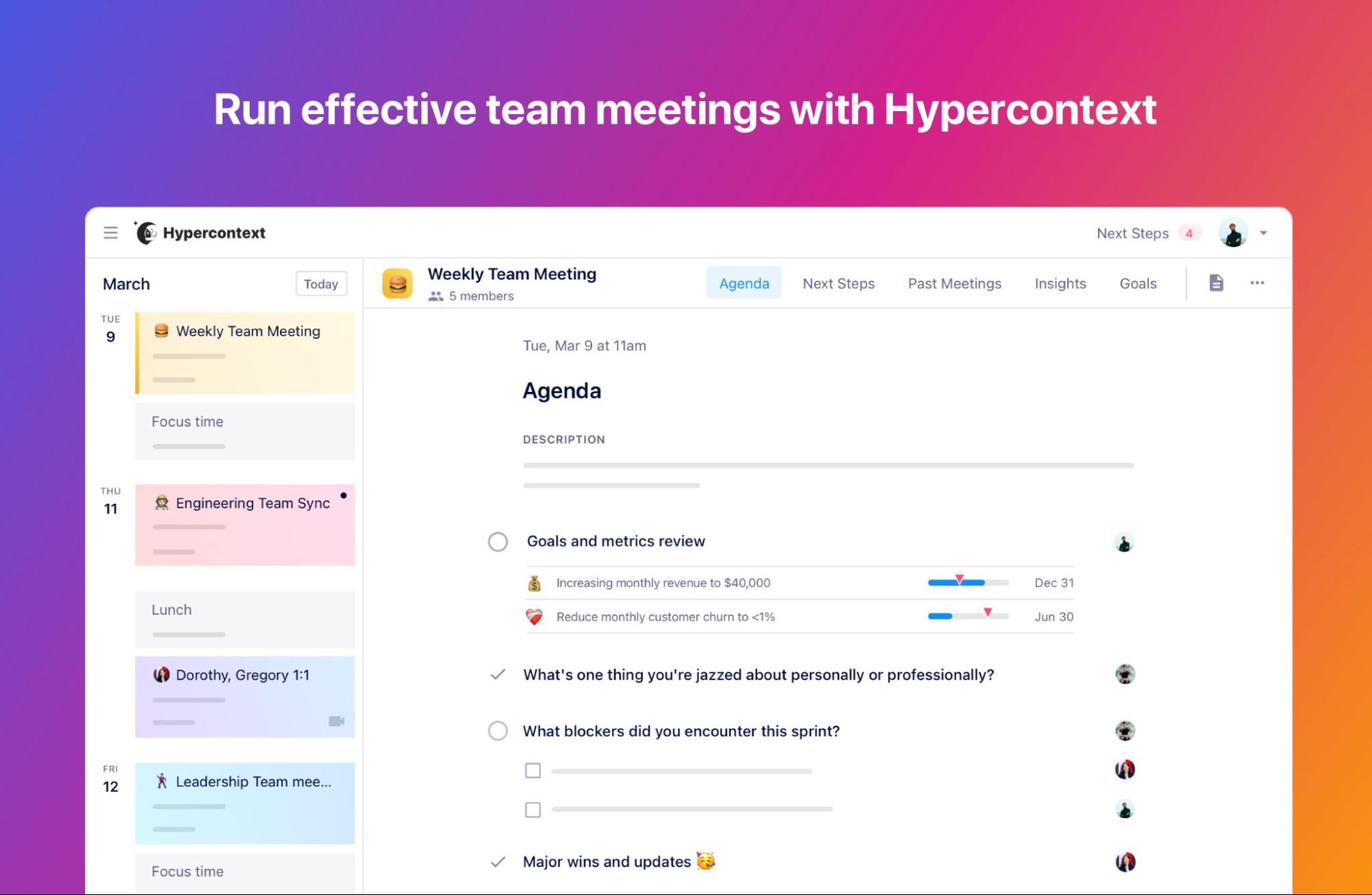
For collaborative leaders (and their employees), project management software is essential. With tools like Trello, Asana, or Monday, stakeholders can keep tabs on a given task or project — and will always know who’s responsible for doing what, and by when.
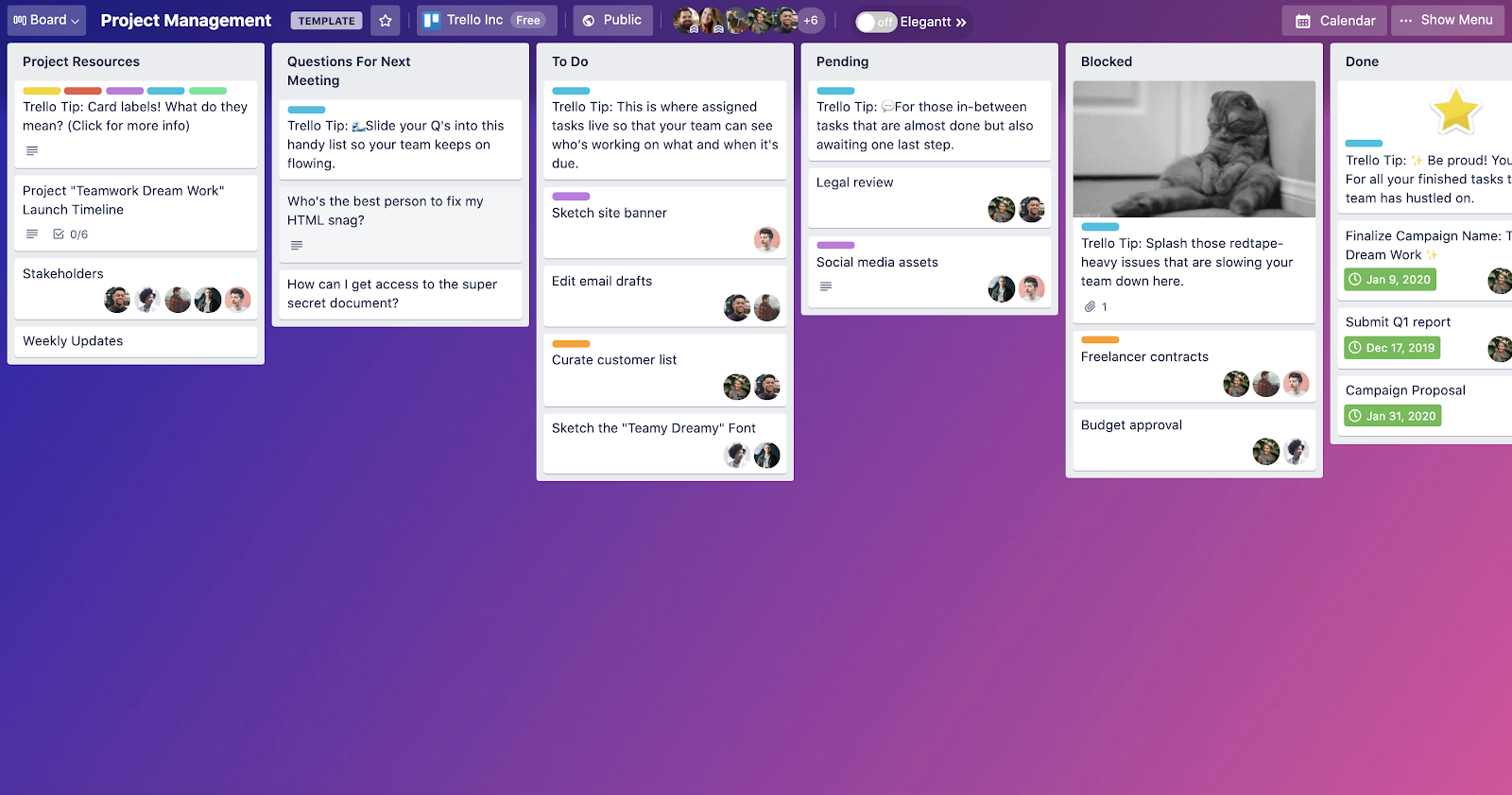 (Source)
(Source)
For improving learning, 360Learning can be used as a collaborative learning platform that allows team members the ability to learn from outside their discipline by building internal courses based on the collective expertise of your organization. In turn, this improvement in knowledge sharing can improve your team’s ability to find different approaches to the project at hand.
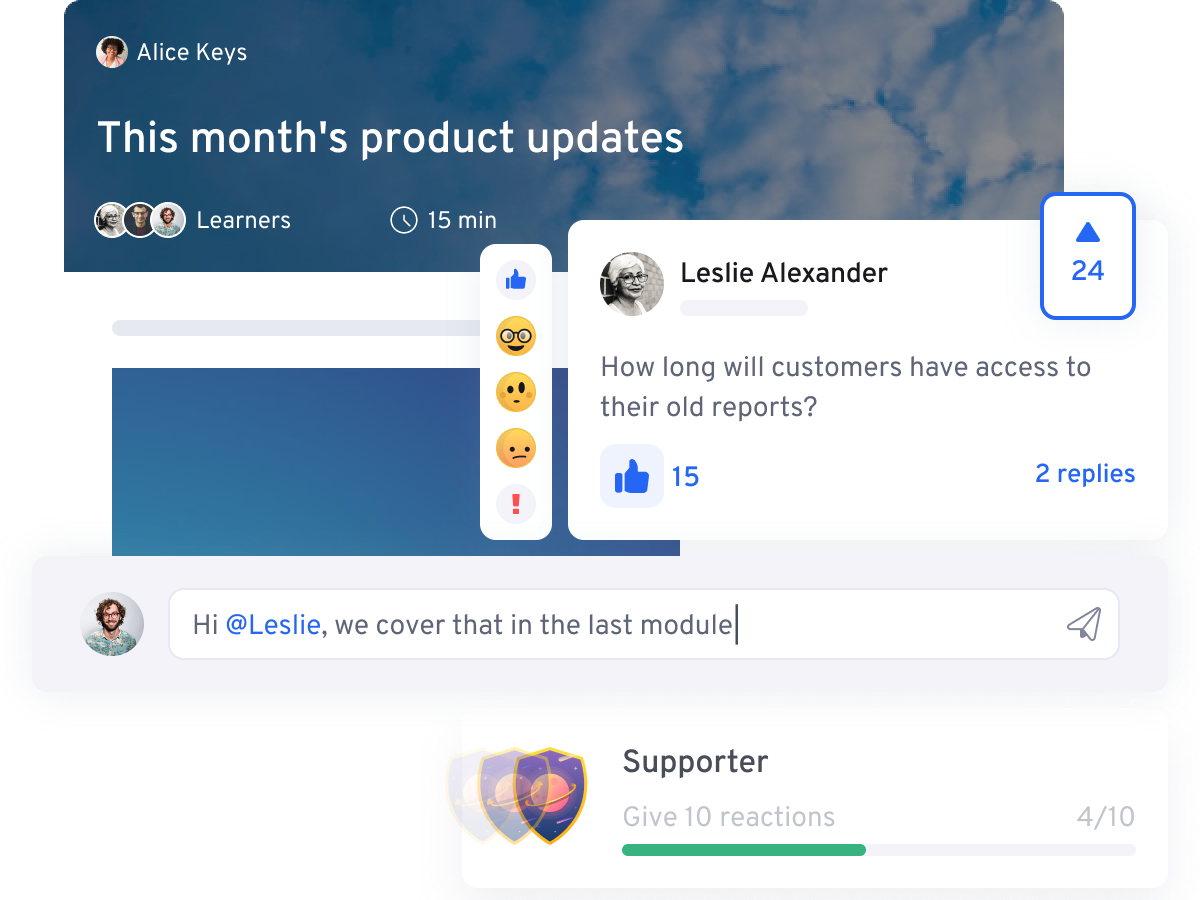
Last but not least, a knowledge base platform such as helpjuice gives organizations the ability to create a knowledge base that acts as a centralized digital space to store, organize, and refer back-to any information and documentation generated during collaborative efforts.
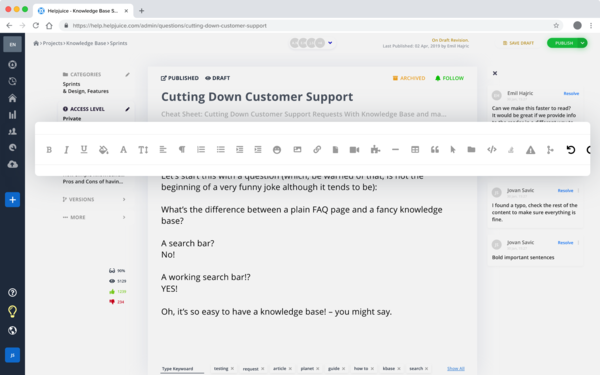
By today’s standards, cross-functional collaboration is quite literally impossible without a robust, cohesive tech stack.
5. Create a Single Source of Truth — and Sync Everything Else
Speaking of cohesion…
Cross-team collaboration requires that all involved parties stay on the same page (literally and figuratively) at all times. If, for example, one party is operating based on out-of-date information, it will throw off their collaborative efforts altogether.
In short, your team needs a single source of truth, or SSOT.
Your SSOT is the center of your knowledge management system.
It’s the digital space that holds master copies of your company’s documents, information, and knowledge — making it the go-to resource for your cross-team collaborative efforts.
You’ll then need to integrate the other tools in your tech stack — with your SSOT and with one another. This will allow information to flow freely between platforms, ensuring it gets to the necessary team members with minimal friction.
In continuing to develop a cohesive knowledge management system, you’ll inherently make it easier and easier for cross-team collaboration to take place.
6. Encourage Knowledge Sharing and Organizational Learning
Again, cross-functional collaboration requires that team members start thinking outside of their interdepartmental “bubble” — and to help their colleagues do the same.
This is where knowledge sharing comes in.
Before you start creating more systematic and systemic collaborative workflows (which we’ll discuss in a moment), it’s crucial to start encouraging your employees to share knowledge freely and regularly.
Storytelling is one of the more powerful ways that you can get employees to buy into the knowledge sharing process.
“I like making use of storytelling to invoke emotion because that’s something that most people can relate to.
As an example, when trying to show how knowledge sharing can make for a better experience for new employees, I like to talk about when I first joined LinkedIn. I walked into a fairly new department that had only been around for two or three years.
As a new employee, there would be times where I needed more information or knowledge to better enable me to successfully complete a task or project. Because there was no central repository holding this essential knowledge, I would have to track who was in charge of the knowledge I was looking for or try to track it down in one of the countless systems that was being used for knowledge storage. The time I was spending on tracking down knowledge would have been better used for allowing me to work on the project at hand and made for a more pleasant working experience.
If you can relate the overall objective to an emotional aspect, getting people to share their knowledge becomes much easier.” - Brock Brown, Instructional Designer and Trainer, Trust & Safety at LinkedIn
Once you’re able to get employees invested into the idea of sharing their knowledge, you’ll want to create a process around how employees can actually share this knowledge so that it can be transferred to other employees.
The basic knowledge sharing and knowledge transfer process is as follows:
- Employees identify the important knowledge they possess that others will need to know when collaborating with certain departments
- Employees capture and store this knowledge, creating text-based and multimedia knowledge assets for others to learn from
- Employees share the knowledge assets actively with others whenever necessary, while also making it easily accessible within your Single Source of Truth
- Knowledge creators and other stakeholders make improvements to knowledge assets over time
Taking this a step further, it’s also vital for learning to take place regularly and naturally throughout your organization.
Facilitating organizational learning involves:
- Creating an environment in which opportunities to learn are prevalent — and taking advantage of these opportunities is celebrated
- Developing more intentional processes and opportunities to learn and grow
- Shifting the focus of leadership toward employee development and ongoing learning
On top of strengthening the bond between your various departments, this will allow for more practical means of engaging with one another as you begin to solidify your cross-functional processes.
7. Systematize Your Collaborative Processes and Efforts
We touched on this a bit earlier, but it’s worth revisiting:
Creating a standardized process for cross-team collaboration is essential for optimizing your team’s efforts.
In many cases, you’ll need to inject cross-team collaboration into existing workflows. For example, you may now have your dev team playing a more active role in the creation of marketing material or sales scripts.
In others, you might have different teams collaborating for completely new purposes. If you’ve just begun building your internal knowledge base, for example, you’ll want to have all hands on deck when developing knowledge assets for all to use.
(It’s also worth mentioning that creating an SOP that discusses workflow for cross-team collaboration will ensure said collaboration only happens when it adds value to the company. In other words, your teams need to know when it’s not all that necessary to collaborate on a certain task.)
At any rate, the key points to define when developing these standardized practices are:
- Which teams are working together — and who, specifically, from each team is involved
- What role each party plays and what tasks they’re responsible for
- What tools will be involved in their collaborative efforts
- How the teams will proceed — and how they’ll know whether or not they’ve succeeded
The clearer everyone is on these standards from the get-go, the better their chances of staying aligned moving forward.
8. Develop KPIs and OKRs Focused on Collaboration
As just mentioned, it’s important for your teams to know what successful cross-team collaboration “looks like” in practice.
This means defining clear Key Performance Indicators, along with Objectives & Key Results, specifically focused on cross-team collaboration.
On an individual level, you’ll be assessing:
- The amount of effort the employee has put into collaborating with other teams
- The employee’s ability to use technology and to otherwise navigate your cross-collaborative processes
- The impact the employee’s collaborative efforts have had on their overall performance and job satisfaction
A few examples of cross-functional OKRs:
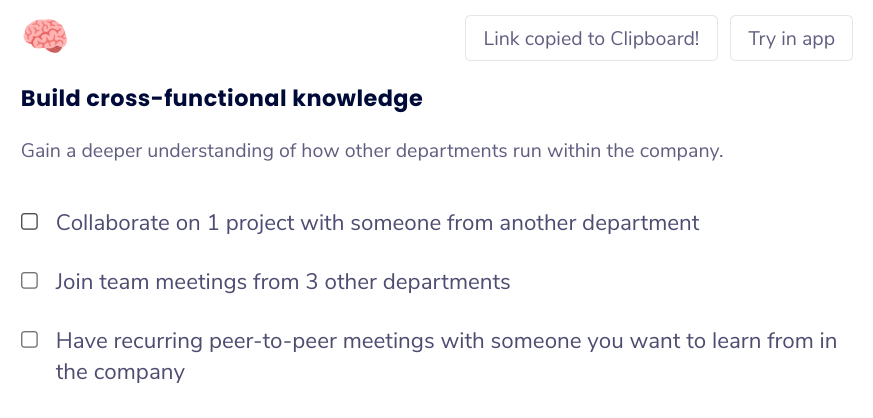
(Source)
In assessing your team’s cross-collaborative efforts as a whole, you’ll want to think both quantitatively and qualitatively.
On the quantitative side, you’ll be looking at the impact your efforts have had on your team’s productivity levels, and on your company’s profit margin. Qualitatively, consider how your efforts have strengthened your company culture and your employees’ general sense of belonging.
By creating these standards upfront, you set the bar for your team’s cross-collaborative efforts from the start — and will be able to keep close tabs on their performance moving forward.
9. Make Continuous Improvements
Under the right conditions, there’s an infinite number of ways for cross-team collaboration to occur within an organization.
Once it’s become more natural for your teams to work together, you’ll want to continue uncovering more, and more effective, ways for them to do so.
This may mean:
- Further developing your organization’s collective vision
- Improving your collaborative workflows
- Enhancing your best practice documentation
- Adding emerging tools to your tech stack as needed
"One thing to note is that a big problem most organizations have is that people who work on different teams aren't able to provide each other with social capital. As such, while you make continuous improvements to your cross-collaborative efforts, you should also look at providing extrinsic and intrinsic rewards to those leading your initiative in the right direction as well as finding ways to publically acknowledge those efforts." - Trevor Larson, CEO, Nectar HR
Once you’ve made the necessary improvements, you can then document the changes made within your internal knowledge base. This will ensure your team members stay in-the-know at all times, and are always able to connect with a colleague to do their best work.
The Power of Many: The Need For Cross-Team Collaboration in the Workplace
Cross-team collaboration is a powerful tool that can help organizations achieve their goals and drive business success. By bringing together diverse perspectives and expertise, cross-team collaboration can lead to great things for your business such as improved communication, enhanced problem-solving, increased efficiency, and enhanced teamwork and collaboration within an organization. While there may be challenges to coordinating schedules and different working styles, these challenges can be overcome by following the steps in our post.
Overall, cross-team collaboration is an essential element of a cohesive as well as an integrated organization and can help organizations reach their full potential by breaking down barriers between teams and promoting the sharing of information and knowledge.
Using Knowledge Base Software to Enhance Cross-Team Collaboration
Knowledge base software can be particularly useful for facilitating cross-team collaboration by providing a centralized location for storing and accessing information and resources that may be relevant to multiple teams or departments.
Some of the ways that a knowledge base can help with cross-team collaboration include:
- Providing a single source of truth so that all members of an organization have access to the same information and resources.
- Facilitating the sharing of knowledge and resources between employees and teams.
- Systemizing the collaborative process and efforts within an organization help to streamline the collaborative process and make it more efficient.
Overall, a knowledge base can be a valuable tool for supporting cross-team collaboration and fostering a cohesive and integrated organization.
Ready to start building your team’s knowledge base? Get started with Helpjuice today.

![16 Best Apps for Employee Communication [2024]](https://static.helpjuice.com/helpjuice_production/uploads/upload/image/4752/direct/1660756026992-Best%20Employee%20Communication%20Apps.jpg)
